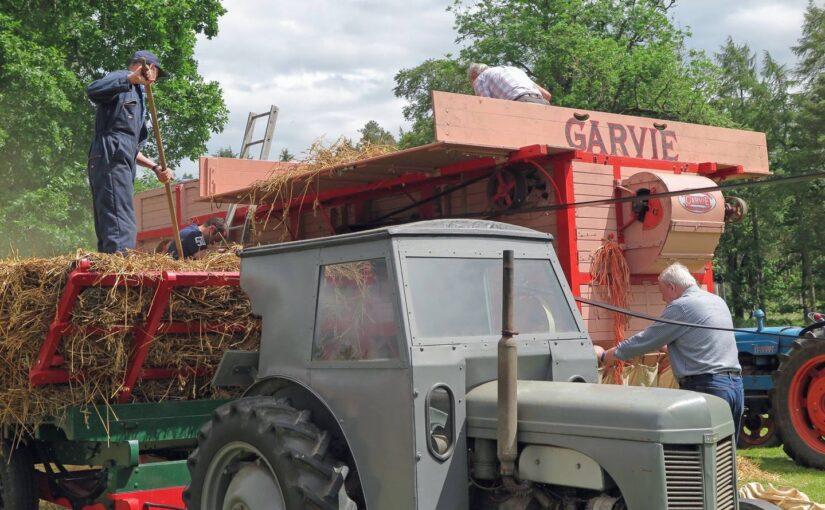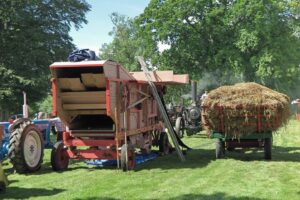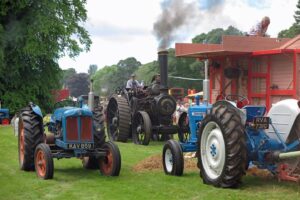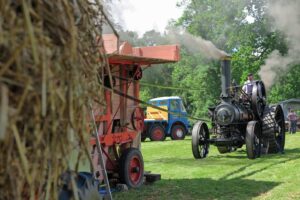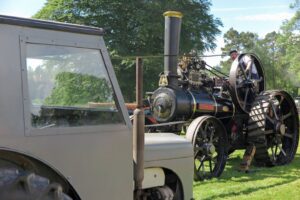There are a number of accounts that describe the work at the travelling mills in parts of Scotland. They are written from a number of accounts, including reminiscence, or accounts from an economic point of view.
We have found two accounts published in newspapers in 1931 and 1939 which describe the work from different perspectives. While they include some of the same elements, they also include further ones.
Both accounts are quoted at length:
An account from the Forfar herald of 11 September 1931:
“Economies
Agriculture: topics of the day
The steam thresher
About 100 years ago our farms were being equipped with water-driven mills. In recent years many of these have been replaced, in the power unit, by oil engines. The dams, lades and sluices are being permitted to fall to ruin. If agriculture in this country is to continue, and we all pray that it may, this change may yet be regretted.
On certain of the post-war holdings, created by sub-division of a larger unit, there is no threshing mill of any kind. The travelling, steam-driven mill is used instead once or twice annually.
Apart from the expense, the objection to this is the difficulty of storing securely in the open a large bulk of straw. And the straw cannot be fed in a fresh condition to the cattle.
Economies
An evil necessity is nowadays imposed on all farmers to cut down their expenses to the minimum essential, and much of the expense in connection with the travelling mill, in the area which I am familiar, would be difficult to justify. Nearly all of us employ the travelling mill occasionally.
Fourteen hands are usually engaged, of which the mill provides two. Extra hands are borrowed from neighbours in return for similar service to be given when required. This borrowing and lending of labour doubtless explains the procedure which obviously dates from the period when the farmer’s entire household, young and old, male and female, turned out to their own and their neighbours’ thresh.
At an early hour the mill driver and his man set about fixing mill and engine in position. This over, they breakfast in the farm kitchen. By about 7.30am a start is made to thresh. At 9am a halt of 10 to 15 minutes is made for beer and pieces. Work is then resumed until 11 am, when fourteen folk sit down to dinner in the farm kitchen.
No light task this for the farmer’s wife, who gets no extra assistance for this addition to her normal day’s routine labours.
She has not long completed the washing up when she has to prepare to supply tea and pieces for the 3pm break of another ten minutes.
At 5 to 5.30pm the mill stops for the day, and fourteen folk again troop to the kitchen for supper.
It is disagreeable to plead for economy, and still more so to apply it. But will anyone deny that the procedure above described partake more of a picnic than of an endeavour to face hard facts?”
An account from the Dundee evening telegraph of 21 February 1939:
“The farmers’ travelling mill
Last season’s corn is still being threshed
Wet days are holidays for the millmen, whose threshing mills, drawn by heavy traction engines, are a common sight on country roads just now. Corn can only be threshed in dry weather.
Mills are an expensive item of farm equipment, and, as they are only needed for a few days each year, framers prefer to hire a travelling thresher when they want to thresh their corn.
Each mill has its own district where it works throughout the season, which ends in late spring, when the last of the corn from the previous year’s harvest is threshed.
Two men travel with the mill. Sometimes they are working near home and can go each night. Often they are so far from home that they have to live in the caravan which they tow behind the mill.
Generally the mill is moved from farm to farm late in the day. Arriving after dark, the millmen are shown where the mill is to be set for the next day’s threshing. For an hour or so they are busy getting into position and levelled up by driving battens under the wheels with heavy hammers.
Spirit levels are fitted into the mill to show when it is dead level. Unless it is level the mill cannot work properly. When it is in position they stop work for the night, but next morning they have to be at work before anyone else.
The mill has to be uncovered and oiled, steam raised in the engine boiler, and the heavy driving belt slipped over the driving wheels, before the farmhands are ready to start work.
During the day the two men still have much to do. While one feeds the corn into the mill drum, which whirls round 1000 times every minute, the other attends to the machinery.
The grain-cleaning apparatus has to be kept in order, the knotting mechanism which ties the straw into trusses has to be attended to, moving parts oiled, and the engine supplied with coal and water. The men relieve each other at short intervals, while feeding the mill is the harder task, attending to the machinery is a dusty and unpleasant job.
At midday, after a meal in the farmhouse, they hurry back to spend the remainder of the midday break oiling and polishing the engine, in which they take great pride.
Threshing starts again at one and goes on till late afternoon, when they take off the driving belt and cover up the mill before going to tea. After tea, they take to the road once more, bound for the next farm on their list.”
The photographs were taken at the Bon Accord Steam Fair, June 2020.
